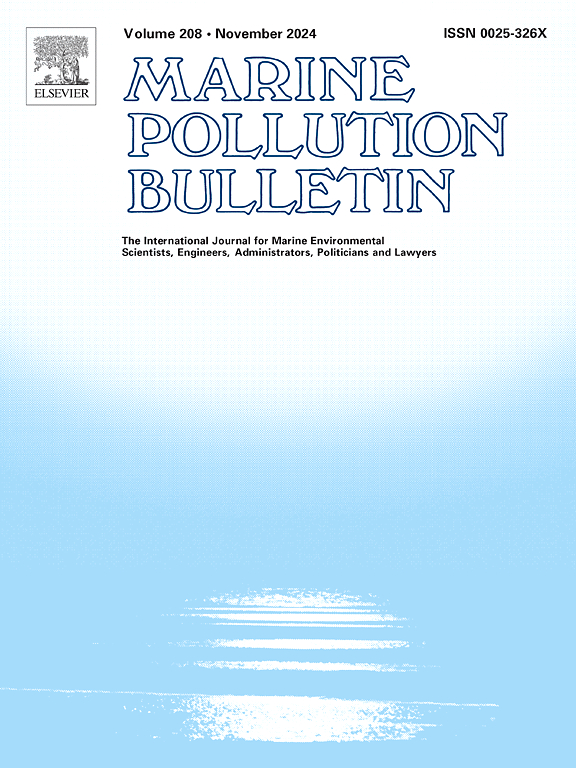Seagrass as a stabilizing environment for benthic foraminifera living in anthropogenically impacted coastal areas
IF 4.9
3区 环境科学与生态学
Q1 ENVIRONMENTAL SCIENCES
引用次数: 0
Abstract
In tropical regions, seagrass meadows provide a unique habitat for benthic foraminifera, both serving as important ecosystem engineers and sensitive indicators of coastal marine ecosystems. However, their interactions remain poorly understood, particularly in the context of anthropogenic pressures and climate change. This study investigates benthic foraminiferal assemblages associated with the tropical seagrass Halophila stipulacea in the Gulf of Aqaba-Eilat (GoA) as a model system to monitor natural and anthropogenic changes. Sampling was conducted during 11 campaigns (January 2020–April 2021) at two sites: South Coast (SC), a pristine shoreline, and North Coast (NC), an urbanized area. At each site, samples were collected from three distinct environments: seagrass leaves (L), sediments within meadows (SIM), and sediments outside meadows (SOM).
Throughout all of the sampling period, we found higher abundance and diversity of benthic foraminifera in sediments within H. stipulacea meadows (SIM) compared with sediments outside meadows (SOM). These results demonstrate that H. stipulacea creates a favorable environment for benthic foraminifera compared to adjacent bare sediments. Notably, the occurrence of certain foraminiferal species in the GoA is directly linked to the presence of seagrass. The leaves also serve as nurseries for juvenile Amphistegina, a key cosmopolitan symbiont-bearing genus. Additionally, the seagrass meadows appear to mitigate anthropogenic impacts, maintaining “healthy” foraminiferal assemblages even in the urbanized northern region of the GoA (NC). These findings highlight the ecological importance of seagrass meadows for benthic foraminifera and emphasize their susceptibility to anthropogenic stressors.

在人为影响的沿海地区,海草作为底栖有孔虫生存的稳定环境
在热带地区,海草草甸为底栖有孔虫提供了独特的栖息地,既是重要的生态系统工程师,也是沿海海洋生态系统的敏感指标。然而,它们之间的相互作用仍然知之甚少,特别是在人为压力和气候变化的背景下。本研究调查了亚喀巴-埃拉特湾热带海草(Halophila tolasacea)的底栖有孔虫组合,作为监测自然和人为变化的模型系统。在11个活动期间(2020年1月至2021年4月),在两个地点进行了抽样:南海岸(SC),一个原始的海岸线,和北海岸(NC),一个城市化地区。在每个站点,从三种不同的环境中收集样本:海草叶片(L),草甸内沉积物(SIM)和草甸外沉积物(SOM)。在整个采样期间,我们发现,与草甸(SOM)外的沉积物相比,草甸(SIM)内沉积物中底栖有孔虫的丰度和多样性更高。这些结果表明,与邻近的裸露沉积物相比,托马藻为底栖有孔虫创造了有利的环境。值得注意的是,果阿邦某些有孔虫物种的出现与海草的存在直接相关。叶子也可以作为幼鱼的苗圃,这是一个重要的世界性共生属。此外,海草草甸似乎减轻了人为影响,即使在果阿邦北部城市化地区也保持了“健康”的有孔虫组合。这些发现强调了海草草甸对底栖有孔虫的生态重要性,并强调了它们对人为压力源的敏感性。
本文章由计算机程序翻译,如有差异,请以英文原文为准。
求助全文
约1分钟内获得全文
求助全文
来源期刊

Marine pollution bulletin
环境科学-海洋与淡水生物学
CiteScore
10.20
自引率
15.50%
发文量
1077
审稿时长
68 days
期刊介绍:
Marine Pollution Bulletin is concerned with the rational use of maritime and marine resources in estuaries, the seas and oceans, as well as with documenting marine pollution and introducing new forms of measurement and analysis. A wide range of topics are discussed as news, comment, reviews and research reports, not only on effluent disposal and pollution control, but also on the management, economic aspects and protection of the marine environment in general.
 求助内容:
求助内容: 应助结果提醒方式:
应助结果提醒方式:


